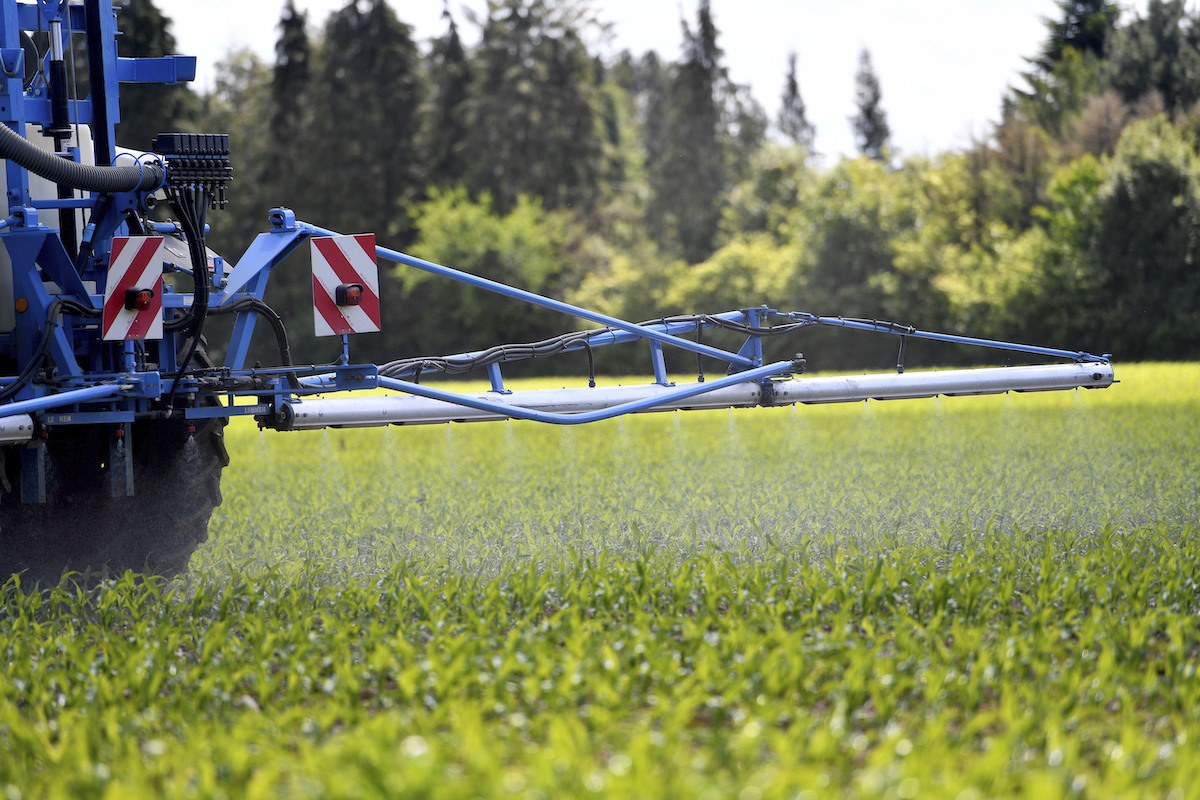
fotokostic/iStock
Although Biden promised to limit people’s exposure to “dangerous chemicals and pesticides,” his EPA has defended multiple Trump-era deregulations.
In his first day in office, President Joe Biden promised to review dozens of Trump-era rollbacks of environmental policies. In the executive order, Biden pledged “to limit exposure to dangerous chemicals and pesticides.”
This article is republished from The Midwest Center for Investigative Reporting. Read the original article here.
But months into the new presidency, the Biden administration has chosen to defend some of the Trump administration’s decisions on pesticides.
These include:
- The Trump administration’s five-year registration of dicamba, despite Biden administration officials declaring in an Inspector General report that there was undue political influence in past dicamba decisions.
- The 11th-hour Trump approval of aldicarb, a highly toxic pesticide banned in more than a hundred countries by international treaty because of its harm to humans. The D.C. District Court recently ruled the EPA violated the law in approving it.
- The expanded use of the pesticide sulfoxaflor, which has been previously banned by courts because of its link to killing bees.
- And the Trump administration’s approval of flea and tick collars containing tetrachlorvinphos, which the Obama-era EPA linked to brain damage in children.
Another stark example is the endangered species assessment of malathion (pronounced mal-uh-thigh-on), a toxic pesticide widely used on crops and to deter mosquitoes.
In 2017, the U.S. Fish and Wildlife Service finalized a draft biological opinion that assessed the harm malathion would have on plants and animals protected by the Endangered Species Act. That assessment, which took years of work by the nation’s wildlife experts, found the continued use of malathion would “jeopardize the continued existence” of 1,284 endangered species, more than four of out five protected species.
It’s a demonstration of the potential long-ranging impact the Trump administration might have on how the federal government interprets the Endangered Species Act.
However, after learning about the findings but before they were made public, then-Deputy Secretary of Interior David Bernhardt — who was later named U.S. Secretary of the Interior — intervened to block the report’s release and changed the methodology behind the document, according to an investigation by The New York Times.
Using the new methodology, the agency came up with a new biological opinion: Malathion is likely to “jeopardize the continued existence” of 78 endangered species — an extremely high number compared to previous agency findings but much less significant than the original.
The determination with the decreased number of endangered species was recently published by the Biden administration. It’s a demonstration of the potential long-ranging impact the Trump administration might have on how the federal government interprets the Endangered Species Act, often considered the nation’s strongest environmental protection law.
“This is (the Biden Administration) perpetuating (Bernhardt’s) radical anti-ESA agenda,” said Lori Ann Burd, environmental health program director for the Center for Biological Diversity. The center sued the federal government to develop the biological opinion, after what it said were decades of inaction on endangered species by federal regulators.
The White House did not respond to a request for comment on the pesticide decisions.
Laury Marshall, a spokeswoman for the U.S. Fish and Wildlife Service, said in an emailed statement that the draft biological opinion for malathion “is a big step forward in our continued understanding of the impacts of malathion use on listed species and critical habitats.
“It will help EPA meet its obligations under the Endangered Species Act and reflects thorough analysis by wildlife experts,” she continued. “Our dedicated experts have ensured the utmost scientific integrity guided their methodology and scientific process.”
Dow Chemical, the maker of malathion, donated $1 million to Trump’s inauguration committee in 2017 and subsequently asked the Trump administration to shelve the endangered species assessments.
An Environmental Protection Agency spokesperson reiterated Biden’s executive order, saying the new administration has a “renewed commitment to protecting human health and the environment” but still defended each of the decisions regarding the three pesticides.
The Trump-era decision on dicamba that the Biden administration is defending was “supported by the agency’s career scientists, and includes measures that are protective of the environment,” the spokesperson said. (The decision that was the subject of the Inspector General did not have staff support, the spokesperson said.)
Also, the decision to register the bee-killing sulfoxaflor was “backed by substantial data,” the spokesperson said.
The Trump administration had close ties with the pesticide industry. Dow Chemical, the maker of malathion, donated $1 million to Trump’s inauguration committee in 2017 and subsequently asked the Trump administration to shelve the endangered species assessments.
Trump also nominated Aurelia Skipwith, a former Monsanto employee, to be the director of the FWS, which oversees endangered species.
Recently, the service announced that it would restore six major rules the Trump administration changed to weaken the Endangered Species Act.
But, with malathion, the Biden administration used the Trump-era methodology, publishing the findings in a recent draft biological opinion. The administration recently took public comment on the decision and will later issue a final decision.
“There’s nothing in here that indicates we’re in a new administration that believes in following science and the law,” Burd said.
Malathion one of three pesticides feds supposed to review
Under a 2014 lawsuit settlement with the Center for Biological Diversity, the EPA and the Fish and Wildlife Service must start issuing nationwide opinions on how three widely-used toxic chemicals affect the nation’s 1,600 or so endangered species: malathion, chlorpyrifos and diazinon.
All three are organophosphate pesticides, which were used as nerve agents during World War II. For decades, they were the most widely used insecticides in the U.S. However, their usage has decreased in recent decades because of their risks to human health.
The agencies were supposed to finalize the biological opinions by 2017, and were on schedule to do so before Bernhardt intervened. A 2017 presentation about the draft report findings said that chlorpyrifos put 1,399 species in peril, malathion put 1,284 species in peril and diazinon put 175 species in peril.
The Biden administration released the malathion opinion in April and has not yet signaled when it will release the diazinon and chlorpyrifos reports. The Ninth Circuit Court of Appeals recently ordered the EPA to ban or limit use of chlorpyrifos because of the risk it poses to children’s brain development, after more than a decade of lawsuits.
The agency is supposed to consider “actual use” of the pesticide, meaning where and when it is sprayed. It’s not supposed to consider “allowed use,” which is what the label says the pesticide can be used for.
The new guidelines that Bernhardt helped outline changed what the federal agency is supposed to consider when making determinations on pesticides. The agency is supposed to consider “actual use” of the pesticide, meaning where and when it is sprayed. It’s not supposed to consider “allowed use,” which is what the label says the pesticide can be used for.
In the biological opinion, the Fish and Wildlife Service said it had difficulty ascertaining “actual use” data in many cases. The service argued the method created a more accurate picture of the “real-world” effects of malathion, but Burd said it allows the agency to pick and choose the effects the pesticide will have.
Under even more settlements, the Fish and Wildlife Service is supposed to continue to release endangered species assessments for pesticides in coming years, including for glyphosate and atrazine, the two most commonly sprayed herbicides in the U.S.
An EPA analysis released in 2020 found that glyphosate likely harms nearly all endangered species.
Last year, Syngenta, the maker of atrazine, voluntarily canceled the use of the herbicide in Hawaii and other U.S. territories because of the risks posed to endangered species.
Biden EPA defends other actions on pesticides
Another pesticide decision the Biden administration has defended concerns dicamba, a widely used herbicide that has skyrocketed in use in recent years after Monsanto released genetically engineered soybean and cotton seeds that could withstand being sprayed by the herbicide.
Last year, the U.S. Ninth Circuit Court of Appeals vacated the registration for the volatile weed killer, after finding that the EPA had underestimated and ignored risks posed by the weedkiller, which has been blamed for millions of acres of damage to crops and natural areas. A recent EPA Inspector General report found that senior Trump administration officials exerted improper political influence in approving the herbicide in 2018.

Soybeans with suspected dicamba damage north of Flatville, IL on Wednesday, August 21, 2019.
Darrell Hoemann, Investigate Midwest
In the months after the Ninth Circuit decision, the EPA assigned 50 employees to restore the registration.
The final decision, which revealed that dicamba damage was worse than previously known, was announced at a press conference with the American Farm Bureau Federation just days before the presidential election in the swing state of Georgia.
The Biden administration has expressed its support for the five-year registration.
Another example is aldicarb, one of just 36 pesticides classified as “extremely hazardous” by the World Health Organization.
In 2010, the EPA and Bayer cancelled the use of the pesticide because of the risks it poses to infants and young children. But earlier this year, the EPA under the Trump administration approved its use Jan. 12 on Florida citrus trees.
The Biden administration defended the approval in federal court, after the Florida Department of Agriculture stepped in and said it would not permit the pesticide’s use because of the EPA’s lack of analysis. In early June, a federal court vacated the EPA’s approval.
The EPA under Biden has also continued to defend the use of sulfoxaflor, a pesticide that the Ninth Circuit Court of Appeals banned in 2015 because of its potential to harm native bees.
In 2016, the EPA issued a more limited use of the pesticide, but the Trump administration expanded those uses in 2019. The Center for Biological Diversity filed another lawsuit challenging that expansion.
Malathion opinion a possible template
The malathion biological opinion is considered to be the template for how these assessments will be conducted.
Jacob Malcom, director of the Center for Conservation Innovation for the Defenders of Wildlife, has studied the Fish and Wildlife Service’s consultations and authored a 2015 study that found the agency rarely makes jeopardy calls — when the agency determines an action could threaten the continued existence of a species, which is prohibited by the Endangered Species Act.
However, Malcom said that pesticide consultations are different from most agency biological opinions. Consultations are more wide-ranging because pesticides are approved all across the country, whereas most agency actions that warrant biological opinions are highly localized.
Malcom said the Fish and Wildlife Service has spent years working out the process for how to do pesticide consultations, and the agency lacks funding to be able to perform the comprehensive efforts required for pesticides.
The 2018 Farm Bill created an interagency working group that included the EPA, Fish and Wildlife Service and other agencies that was tasked with improving the consultation process on pesticides.
Consultations are more wide-ranging because pesticides are approved all across the country, whereas most agency actions that warrant biological opinions are highly localized.
Despite the effort, Malcom said the malathion biological evaluation is lacking.
“If they go through and finalize this biological opinion, I can’t imagine they’re not going to get sued,” he said. “It’s really hard to imagine they’re on solid ground with this interpretation.”
Malcom said it’s possible it was strategic for the service to release the document now to solicit public input on “this cockamamie idea of how you do analysis.”
“Not to make excuses or anything, but the wheels of bureaucracy turn very slowly,” he said. “They may have a good reason to believe that putting this out and opening it up to public comment could get them back to what is needed.”
But flaws in the draft biological opinion show the Biden administration was fine releasing an incomplete document, said Burd, of the Center for Biological Diversity.
The document does not have any information on how much incidental take — when an endangered species is harmed by an otherwise lawful action — will happen. The assessment also does not go into detail on steps to mitigate the harm to the 78 species that may no longer exist because of malathion, Burd said.
“What are we commenting on here? Nothing. We’re commenting on the analysis,” Burd said. “They don’t include a single thing about how they’re going to protect species in this document.”









